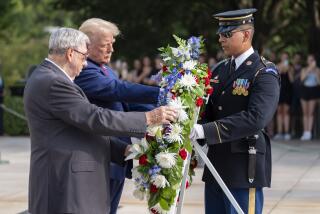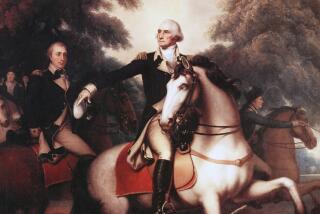TAKING THE KIDS : Living History Lessons at U.S. Presidents’ Sites : Plan a trip outdoors where children can experience what life was really like in Lincoln’s or Washington’s day.
- Share via
GETTYSBURG, Pa. — “It’s impossible. The soldiers couldn’t have done it that fast,” Matt declared, shaking his head.
My son Matt and daughter Reggie tried to simulate the way the Civil War soldiers reloaded and fired their cannons during the Battle of Gettysburg, by following our battlefield guide’s instructions.
The soldiers fired three times a minute but despite their best efforts, Matt and Reggie couldn’t come close. Yet this wasn’t a lesson in firearms. The kids didn’t realize it but they were getting a lesson in history. And as we toured Gettysburg National Military Park that afternoon, listening to guide Ed Guy’s stories about the soldiers and the battle, we all gained a new understanding of the men who fought in the Civil War, of the enduring power of Abraham Lincoln’s Gettysburg Address and of the toll that the fight for freedom and equality really took on America. And is still taking.
As we celebrate Presidents Day and get a lot of “Why is this important?” questions from the kids--it’s worth taking note of the lasting value of a trip into history at places such as Gettysburg, site of the crucial Civil War battle and famous Lincoln address dedicating the cemetery there, or to Mount Vernon, the home and burial place of George Washington. Each are within about an hour’s drive of Washington and are worth the detour. If my kids are any indicator, a single afternoon’s excursion can give them at least a basic appreciation for the accomplishments of two of our great presidents.
Suddenly, boring irrelevant history--and the people who made it--becomes real. There are lots of opportunities to make that happen--visits to historically important places, stories about the lives of historic figures, movies about life in different eras. Once children’s interest is sparked, questions are bound to become a lot more pointed. If you’re at Gettysburg, as we were, the questions may be about the contradictions of war and even the specifics of battle strategy (make sure you know the answers), as the kids walk through a battlefield, imagining the Civil War raging or run in the gardens where George Washington once walked.
Stretching across 17 acres, Gettysburg National Cemetery was built to provide proper graves for the thousands of Union soldiers who were killed in the battle there. Immediately afterward, historians say, Lincoln turned to a friend and pronounced his speech “a flat failure,” but his brief remarks made Gettysburg an enduring symbol of soldier sacrifice.
Just 78 miles from Washington, Gettysburg was the site of the three-day battle that turned the tide of the Civil War in favor of the Union Army. On the peaceful Pennsylvania farm fields more than 51,000 men were killed or wounded--more than in any other battle ever fought in North America. Now a National Military Park, the battlefields include more than 1,300 markers and monuments and nearly 400 cannons and pieces of artillery.
A few days later, the kids gained an initial understanding of an earlier period in American history by visiting George Washington’s home, Mount Vernon, just 16 miles south of Washington.
Like the historians at Gettysburg, those who oversee Mount Vernon work hard to make an experience with kid-appeal. For example, in conjunction with the Boy Scouts, Girl Scouts and Camp Fire Clubs, Mount Vernon officials have designed a special Historic Trail Hike for children. Youngsters who complete the trail around the grounds and answer questions in the booklet provided free at the entrance gate (just ask for the Scouts’ Historic Trail Guide) are eligible for a patch that can be sewn onto their Scout uniforms.
The questions, of course, are devised to encourage grade schoolers’ interest in George Washington. (Why was the kitchen of the Estate in a separate building? Not only because fire was a hazard; the separation kept odors and flies away from the house.)
Gettysburg plans special events around the anniversary of the battle. (Next July marks the 130th anniversary. Write to the Gettysburg Travel Council, 35 Carlisle St., Gettysburg, Pa. 17325, 717- 334-6274, for information about planned battle re-enactments, accommodations and other attractions, including the nearby farm where President Dwight Eisenhower lived after he left the White House.)
Mount Vernon, meanwhile, offers special activities in the weeks around George Washington’s birthday this month. On weekdays from Feb. 16 through March 12, Colonial crafts will be demonstrated by skilled craftsmen dressed in period clothing. Craftsmen will include a blacksmith, Continental Army soldier, candle maker and even a military surgeon. Schools in the area are encouraged to bring children on field trips during this time.
Our kids actually had more fun outside--exploring the extensive gardens and grounds, looking at the kitchen, visiting Washington’s tomb--than viewing the meticulously-restored rooms of the mansion, though they were impressed by the four-poster bed where Washington died. It didn’t matter how many historic details they got right. Just being there helped make George Washington real for them. And it helped them grasp the importance of his role in the nation’s history.
(Mount Vernon is open every day of the year. For information: 703-780-2000.)
At Gettysburg, we didn’t have to work to keep the children interested. Our guide Guy, an artist and amateur historian, had plenty of stories and anecdotes that kept the kids involved and asking questions.
(Battlefield Guides, licensed and supervised by the National Park Service, may be requested at the Visitor Center year round. They charge $20 for a two-hour tour. In spring and summer, park rangers also offer guided walks of the cemetery and battlefields. Ranger-run campfires are a particular hit with junior visitors in summer.)
Matt loved the story of the dog named Sally, the mascot of a Pennsylvania regiment who is the only dog honored with its own battlefield statue. The dog refused to leave the side of his injured masters who had fallen on the battlefield and was killed there, by their sides.
The kids enjoyed climbing on the rocks at Big Round Top and Little Round Top, the hills where the Union soldiers waited for attacks by the South. They listened intently as the guide described the lives of some of the soldiers who were buried in the cemetery.
Inside the Visitors’ Center were displays of soldiers’ military paraphernalia--everything from decks of cards and dice to uniforms and boots to drums and bugles--which all helped to make the battle and the men who fought it seem real. There is a huge electric map that recreates the battle and a cyclorama program, complete with lights and sound, describes the famous 356-foot circular painting, “Pickett’s Charge.”
“I’ve never seen a child have a bad time here,” said ranger/historian Tom Holbrook. “They may not understand all of the complexities but they ask questions and then you can teach them.”
Taking the Kids invites reader questions and comments about family travel. Address them to: Taking the Kids, 2859 Central St., Box 119, Evanston, Ill. 60201.
More to Read
Sign up for The Wild
We’ll help you find the best places to hike, bike and run, as well as the perfect silent spots for meditation and yoga.
You may occasionally receive promotional content from the Los Angeles Times.






